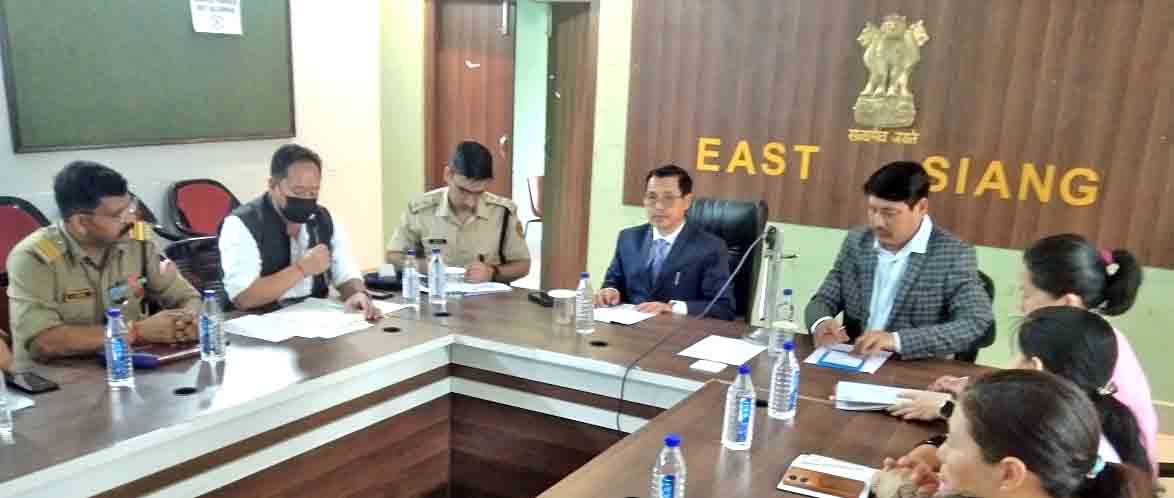-
Former DDSE arrested for illegal appointments in education …
-
Tobacco control cell raids shops near schools, destroys seized…
-
Arunachal Pradesh Raj Bhavan celebrates Gujarat & Maharashtra…
-
Internationally recognized counseling center opens in Ziro
-
Batchmates pay tribute to late Sangay Lhaden, dedicates …
-
Security forces arrest over ground worker of NSCN-KYA
-
Precious Cargo: The Journey of 2 Steel Trunks From…
-
 Governor emphasises on using technology on the ground
Governor emphasises on using technology on the ground
-
AAPSU stops debate on Chakmas at Rajiv Gandhi University
-
 East Siang DA takes stock of monsoon preparedness
East Siang DA takes stock of monsoon preparedness
On Saturday the Union Health Ministry said that India has conducted over 4.20 lakh Covid-19 tests on Friday, the highest ever single-day testing so far. This is encouraging given the fact that caseloads have seen an addition of 45000 for preceding three consecutive days and signs are much clearer that there will now be a greater momentum towards reaching the peak. At this juncture which can only be termed as something like ‘race against time’, it needs reiterating that the above ‘healthy’ figure of testing needs to be taken to a further aggressive note due to a set of troubling factors which are increasingly getting prominent. While community transmission is still a raging topic, the current daily positivity rate which stands out to be far from the safe levels is the new worry. At this backdrop, WHO Chief Scientist’s statement on Friday that herd immunity may be a long way still becomes significant. Both of these, i.e. India’s Covid-19 positivity rate and WHO’s scientist’s ‘admission’ reflect that current criticality of the situation will persist for an indefinite tenure, thereby making testing more indispensable in coming weeks.
There had been a lot of furore in the initial Covid days with a deluge of blames coming from various global health watchdogs that India, in proportion to its population, was just not doing enough testing. As per official figures, since March, from a meagre 120+ labs across the country, in July it’s 1,301 and 1.58 crore tests have been conducted with an average testing capacity of 11,484 tests per 10 lakhs. While it may be argued that the initial lacunae in conducting tests has been made good to a substantial extent, worry still remains since the positivity rate which is the number of samples that test positive among the total tests conducted currently stands at 11.61 %. This is particularly worrisome since WHO has stated in clear terms that a positivity rate over 10% in a country is a reliable indicator that testing capacity is limited only in the high-risk category, i.e., people most susceptible to get infected, which otherwise hints at a lack of uniformity in testing on an overall basis. As per current Covid fightback guidelines, ideally, the positivity rate should be below 5 % at least for two weeks in a row when it can be called real signs of success.
It also needs reiteration that aggressive testing besides in the declared vulnerable zones must also be carried out with equal zeal in the Northeast states such as Arunachal and Assam which are catching up fast in terms of Covid vulnerability.
Aggressiveness without uniformity will fetch limited success and for a pan-India Covid clean-up, the latter factor needs to be given more stress.
On Saturday the Union Health Ministry said that India has conducted over 4.20 lakh Covid-19 tests on Friday, the highest ever single-day testing so far. This is encouraging given the fact that caseloads have seen an addition of 45000 for preceding three consecutive days and signs are much clearer that there will now be a greater momentum towards reaching the peak. At this juncture which can only be termed as something like ‘race against time’, it needs reiterating that the above ‘healthy’ figure of testing needs to be taken to a further aggressive note due to a set of troubling factors which are increasingly getting prominent. While community transmission is still a raging topic, the current daily positivity rate which stands out to be far from the safe levels is the new worry. At this backdrop, WHO Chief Scientist’s statement on Friday that herd immunity may be a long way still becomes significant. Both of these, i.e. India’s Covid-19 positivity rate and WHO’s scientist’s ‘admission’ reflect that current criticality of the situation will persist for an indefinite tenure, thereby making testing more indispensable in coming weeks.
There had been a lot of furore in the initial Covid days with a deluge of blames coming from various global health watchdogs that India, in proportion to its population, was just not doing enough testing. As per official figures, since March, from a meagre 120+ labs across the country, in July it’s 1,301 and 1.58 crore tests have been conducted with an average testing capacity of 11,484 tests per 10 lakhs. While it may be argued that the initial lacunae in conducting tests has been made good to a substantial extent, worry still remains since the positivity rate which is the number of samples that test positive among the total tests conducted currently stands at 11.61 %. This is particularly worrisome since WHO has stated in clear terms that a positivity rate over 10% in a country is a reliable indicator that testing capacity is limited only in the high-risk category, i.e., people most susceptible to get infected, which otherwise hints at a lack of uniformity in testing on an overall basis. As per current Covid fightback guidelines, ideally, the positivity rate should be below 5 % at least for two weeks in a row when it can be called real signs of success.
It also needs reiteration that aggressive testing besides in the declared vulnerable zones must also be carried out with equal zeal in the Northeast states such as Arunachal and Assam which are catching up fast in terms of Covid vulnerability.
Aggressiveness without uniformity will fetch limited success and for a pan-India Covid clean-up, the latter factor needs to be given more stress.

Kenter Joya Riba
(Managing Editor)She is a graduate in Science with post graduation in Sociology from University of Pune. She has been in the media industry for nearly a decade. Before turning to print business, she has been associated with radio and television.
Email: kenterjoyaz@easternsentinel.in / editoreasternsentinel@gmail.com
Phone: 0360-2212313

